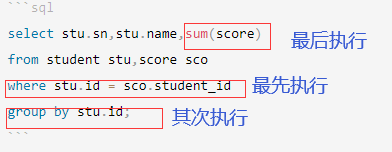在where后面,不要出现聚合函数。
一般先执行where语句,在执行分组语句,最后执行聚合函数
GROUP BY子句(分组的意思)
SELECT 中使用 GROUP BY 子句可以对指定列进行分组查询。需要满足:使用 GROUP BY 进行分组查询时,SELECT 指定的字段必须是“分组依据字段”,其他字段若想出现在SELECT 中则必须包含在聚合函数中。
案例:
准备测试表及数据:职员表,有id(主键)、name(姓名)、role(角色)、salary(薪水)
create table emp(
id int primary key auto_increment,
name varchar(20) not null,
role varchar(20) not null,
salary numeric(11,2)
);
insert into emp(name, role, salary) values
('马云','服务员', 1000.20),
('马化腾','游戏陪玩', 2000.99),
('孙悟空','游戏角色', 999.11),
('猪无能','游戏角色', 333.5),
('沙和尚','游戏角色', 700.33),
('隔壁老王','董事长', 12000.66);
--查询每个角色的最高工资、最低工资和平均工资
select role,max(salary),min(salary),avg(salary) from emp group by role;
HAVING
使用GROUP BY 子句进行分组以后,需要对分组结果再进行条件过滤时,不能使用 WHERE 语句,而需要用
HAVING,其功能相当于where,和GROUP BY搭配使用
--显示平均工资低于1500的角色和它的平均工资
select role,max(salary),min(salary),avg(salary) from emp group by role
having avg(salary)<1500;
联合查询
1、什么是联合查询:就是两张表或者两张以上的表,进行 连接查询。
2、为什么要联合查询:就是因为,我们所需要的数据,不 仅仅是来自于一张表的,他是来自于多张表的。所以,我们 要进行联合查询!!!
3、前置知识:笛卡尔积!!! 排列组合而已!
笛卡尔积:

建表进行联合查询
drop database if exists test0311;
create database test0311;
use test0311;
drop table if exists classes;
create table classes(
id int primary key auto_increment,
name varchar(50),
`desc` varchar(50)
);
insert into classes(name, `desc`) values
('计算机系2019级1班', '学习了计算机原理、C和Java语言、数据结构和算法'),
('中文系2019级3班','学习了中国传统文学'),
('自动化2019级5班','学习了机械自动化');
drop table if exists student;
create table student(
id int primary key auto_increment,
sn int,
name varchar(30),
qq_mail varchar(30),
classes_id int
);
insert into student(sn, name, qq_mail, classes_id) values
('09982','黑旋风李逵','xuanfeng@qq.com',1),
('00835','菩提老祖',null,1),
('00391','白素贞',null,1),
('00031','许仙','xuxian@qq.com',1),
('00054','不想毕业',null,1),
('51234','好好说话','say@qq.com',2),
('83223','tellme',null,2),
('09527','老外学中文','foreigner@qq.com',2);
drop table if exists course;
create table course(
id int primary key auto_increment,
name varchar(20)
);
insert into course(name) values
('Java'),('中国传统文化'),('计算机原理'),('语文'),('高阶数学'),('英文');
drop table if exists score;
create table score(
id int primary key auto_increment,
score DECIMAL,
student_id int,
course_id int
);
insert into score(score, student_id, course_id) values
-- 黑旋风李逵
(70.5, 1, 1),(98.5, 1, 3),(33, 1, 5),(98, 1, 6),
-- 菩提老祖
(60, 2, 1),(59.5, 2, 5),
-- 白素贞
(33, 3, 1),(68, 3, 3),(99, 3, 5),
-- 许仙
(67, 4, 1),(23, 4, 3),(56, 4, 5),(72, 4, 6),
-- 不想毕业
(81, 5, 1),(37, 5, 5),
-- 好好说话
(56, 6, 2),(43, 6, 4),(79, 6, 6),
-- tellme
(80, 7, 2),(92, 7, 6);
查询“许仙”同学的 成绩 我们可以发现,要求的信息来 自于2张表。 学生表 成绩表
--方式一
select stu.sn,stu.name,sco.score,cou.name as 课程名 from student stu
inner join score sco on stu.id = sco.student_id
inner join course cou on sco.course_id = cou.id
and stu.id=4;
--方式二
select stu.sn,stu.name,sco.score,cou.name as 课程名 from student stu
inner join score sco on stu.id = sco.student_id
inner join course cou on sco.course_id = cou.id
and stu.name='许仙';
--方式三
--1、inner可以省略
--2、或者可以省略join on
select stu.sn,stu.name,sco.score,cou.name as 课程名
from student stu ,score sco,course cou
where stu.id = sco.student_id
and sco.course_id = cou.id
and stu.name='许仙';
--一般方式三用的比较多;
查询每个同学的总成绩,及同学的个人信息
不用求课程名
select stu.sn,stu.name,sum(score)
from student stu,score sco
where stu.id = sco.student_id
group by stu.id;

外连接
外连接分为左外连接和右外连接。如果联合查询,左侧的表完全显示我们就说是左外连接(不管条件满足与否);右侧的表完全显示我们就说是右外连接。
例如:
-- 查询每个同学的成绩,及同学的个人信息,
--如果该同学 没有成绩,也需要显示该同学
select stu.id,stu.name,sco.score
from student stu
left join score sco on stu.id = sco.student_id
group by stu.id;

自连接
自连接是指在同一张表连接自身进行查询。
案例:
显示所有“计算机原理”成绩比“Java”成绩高的成绩信息
select s2.* from score s1,score s2
where s1.student_id=s2.student_id
and s1.course_id=1 --java的id 为1
and s2.course_id=3 --计算机原理的ID为3
and s1.score<s2.score;
子查询
子查询是指嵌入在其他sql语句中的select语句,也叫嵌套查询
单行子查询:返回一行记录的子查询
例如:查询与“不想毕业” 同学的同班同学:
--1、先查这个人是哪个班的?
select classes_id from student stu
where stu.name='不想毕业';
--2、查1班有写谁?
select * from student
where classes_id = 1;
--3、合并
select * from student where classes_id = (select classes_id from student stu
where stu.name='不想毕业');
多行子查询:返回多行记录的子查询
例如:查询“语文”或“英文”课程的成绩信息
[NOT] IN关键字:
-- 使用IN
select * from score where course_id
in (select id from course where
name='语文' or name='英文');
-- 使用 NOT IN
select * from score where course_id
not in (select id from course where
name!='语文' and name!='英文');
exists:(了解)
EXISTS(表达式) 只要这个表达式为真 就返回true。
例如这条SQL语句:
SELECT * FROM A WHERE EXISTS (SELECT 1 FROM B WHERE B.id = A.id);
1、首先执行一次外部查询,并缓存结果集,如 SELECT * FROM A
2、遍历外部查询结果集的每一行记录R,代入子查询中作 为条件进行查询,如 SELECT 1 FROM B WHERE B.id = A.id
3、如果子查询有返回结果,则EXISTS子句返回TRUE,这 一行R可作为外部查询的结果行,否则不能作为结果
合并查询
在实际应用中,为了合并多个select的执行结果,可以使用集合操作符 union,union all。使用UNION和UNION ALL时,前后查询的结果集中,字段需要一致。
union
该操作符用于取得两个结果集的并集。当使用该操作符时,会自动去掉结果集中的重复行。
案例:查询id小于3,或者名字为“白素贞”的学生:
select * from student where id<=3
union
select * from student where name='白素贞';
union all
该操作符用于取得两个结果集的并集。当使用该操作符时,不会去掉结果集中的重复行。
案例:查询id小于3,或者名字为“白素贞”的学生:
select * from student where id<=3
union all
select * from student where name='白素贞';





















 5994
5994











 被折叠的 条评论
为什么被折叠?
被折叠的 条评论
为什么被折叠?








